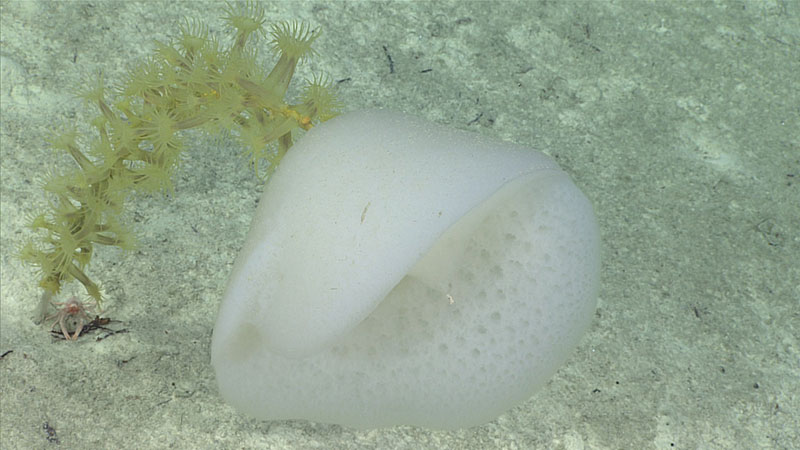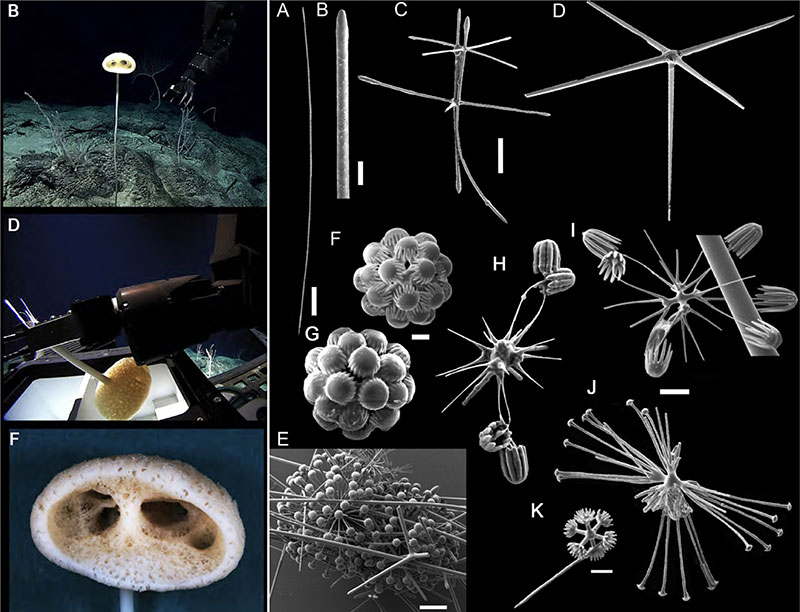Illuminating Biodiversity in Deep Waters of Puerto Rico 2022
April 6 - 19, 2022
[ Disponible en español ]
Sponge Hunting in Deep Waters of Puerto Rico, Why?
Despite their importance in the deep-ocean ecosystem in providing habitat and food for a diversity of other marine life, scientists know very little about deep-sea sponges. Work done on sponges collected during the Illuminating Biodiversity in Deep Waters of Puerto Rico expedition will help fill some of the gaps in our understanding of these important animals.
Investigate almost any biological community living on the bottom of the ocean and you will find a lot of amazing animals known as sponges. From tiny crusts to huge body shapes, we see both a large number of individuals and a wide variety of types of sponges. Sponges are generally pumping water through pores and a series of canals and chambers, from which prey items like bacteria and other minute, single-celled organisms are consumed. The water is then pumped out through one or more larger openings.
These filtering animals serve many roles in the environment, not the least of which is providing structure that supports a surprising diversity of life. Another important role of marine sponges is serving as food for fishes, turtles, worms, sea stars, and more. Sponges are also famous for harboring a lot of bacteria inside their own cells (up to 40% of their body mass), but all their crevices and canals can also be the homes of various shrimps and worms. And finally, even the nooks and crannies of sponge bodies, especially ones that grow large (even the size of a van!), can provide a myriad of perches and safe havens for animals such as brittle stars, comb jellies, crabs, and even fishes. In this role, sponges in the deep sea, along with corals, provide particularly important habitats for fishes and the prey items of fishes. Lastly, those tiny microbial organisms that live in sponges produce proteins that biomedical scientists study for anti-tumor, anti-fungal, anti-bacterial, and other properties.

With how important these animals are to the functioning of marine ecosystems upon which we rely, you might be surprised to find out how little we know about them. So far, scientists have named and described about 9,000 species, many based on just a single specimen, but we estimate that there are likely three times that number sharing the planet with us, leaving taxonomists and biodiversity scientists with a lot of fun work to do.
This is what brings us to Puerto Rico. Only a few miles off the coast of Puerto Rico lie extensive, complex habitats, including submarine canyons, ridges, and banks, that are among the least explored areas in U.S. waters. This means that when we get the remotely operated vehicle to the ocean bottom, it is a near certainty that we will encounter species that are new to science.
When we sample sponges, we will carefully prepare them so that their morphology and genetics can be characterized, essentially “made known,” At the same time, we will be making detailed observations about habitat, what other animals are living alongside the sponges, and even loose DNA captured from the surrounding water. This latter sampling of environmental DNA (eDNA) will likely give us the “genetic signature” of even more sponges living in the area, but we will have to wait and see if this expectation is met.
The taxonomic work on sponges collected from the deep waters of Puerto Rico will help fill in the gaps of our basic knowledge about these incredibly important creatures, unlocking their secrets for still other scientists to explore.

By Allen Collins, Co-Principal Investigator, NOAA Fisheries National Systematic Laboratory and Smithsonian National Museum of Natural History and Cristiana Castello-Branco, Postdoctoral Fellow, Smithsonian National Museum of Natural History
Published April 11, 2022